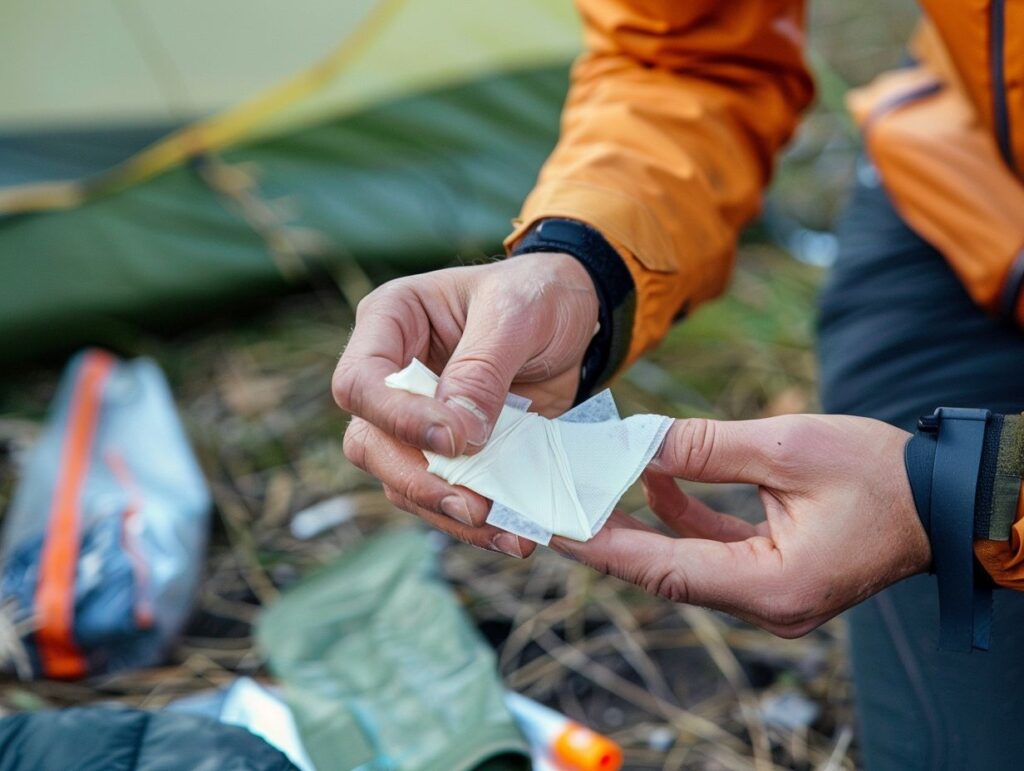Heading out for a camping trip? It’s important to be prepared for any unexpected injuries or emergencies that may arise.
We provide essential first aid tips to keep you safe and prepared while out in the great outdoors. From treating cuts and scrapes to handling burns and allergic reactions, we’ve got you covered.
Learn what to include in your first aid kit, when to seek professional medical help, and more to ensure a safe and enjoyable camping experience.
Key Takeaways:
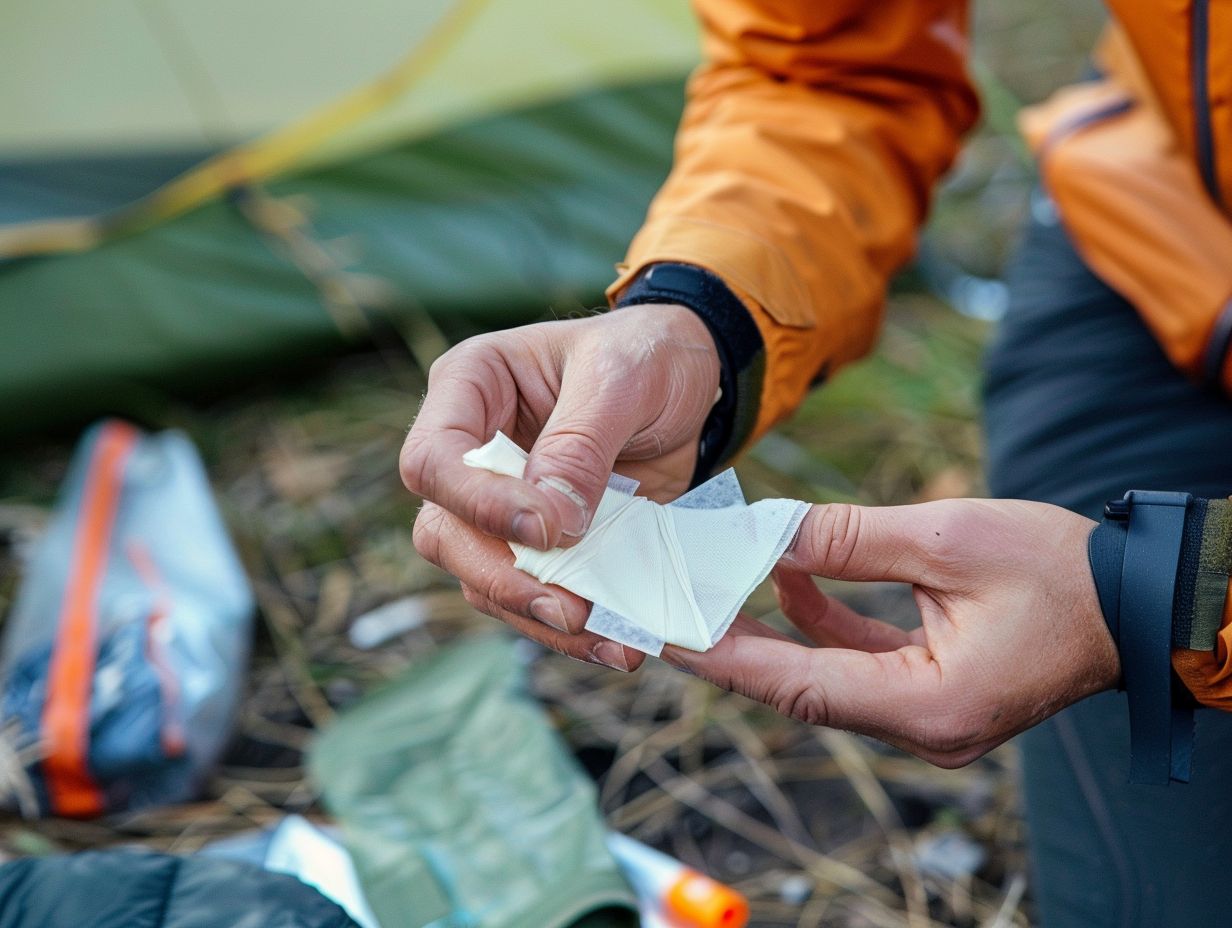
- Know the contents and location of your first aid kit before heading to camp.
- Pack essential items such as bandages, pain relievers, and emergency contact information in your first aid kit.
- Seek professional medical help for severe injuries or illnesses, allergic reactions, persistent symptoms, or difficulty breathing or chest pain.
Basic First Aid Tips for Campers
For individuals who are passionate about outdoor activities and camping, possessing a firm grasp of fundamental first aid principles is essential to guarantee safety and readiness throughout wilderness escapades.
When engaging in camping experiences in isolated areas, possessing the expertise and necessary resources to address typical injuries and medical crises can prove to be pivotal.
1. Know Your First Aid Kit
A properly stocked first aid kit is fundamental for preparedness in any outdoor excursion, and being knowledgeable about the contents of the first aid kit can greatly enhance one’s ability to respond effectively to medical emergencies.
Within a first aid kit, items such as antiseptics play a pivotal role in the prevention of infections. For instance, the application of antiseptic wipes or sprays to cuts or wounds aids in cleansing and disinfecting the affected area before bandaging.
Gauze pads are critical for covering larger wounds or burns, safeguarding them from contamination and further harm. Tweezers serve a practical purpose in the removal of splinters or foreign objects from a wound. Proficiency in utilising these items correctly can have a substantial impact on the outcome of a first aid crisis.
2. Be Prepared for Common Injuries
Preparation for common injuries such as fractures, sprains, and wounds is a crucial component of backcountry safety for campers and hikers. Understanding how to effectively manage these injuries can significantly impact the outcome of a wilderness excursion.
Fractures may necessitate immobilisation using improvised splints, while sprains can benefit from rest, ice, compression, and elevation (R.I.C.E method). Proper wound management, involving timely cleaning, disinfection, and dressing of wounds, is imperative to prevent infection.
It is essential to carry a well-equipped first aid kit containing essential supplies like bandages, antiseptic wipes, and painkillers to ensure swift and effective treatment of injuries. Possessing knowledge of basic first aid techniques and having a clearly defined plan in case of emergencies can help guarantee a safe and enjoyable camping or hiking experience.
3. Know How to Treat Cuts and Scrapes
Understanding the proper procedures for treating cuts and scrapes is imperative for maintaining wound care standards and preventing infections, particularly during outdoor excursions such as camping trips.
When addressing a cut or scrape, the initial step involves delicately cleansing the wound with a mild soap and water solution to eliminate any dirt or debris present. Following cleansing, it is crucial to administer an antiseptic agent such as hydrogen peroxide or rubbing alcohol to sanitize the affected area and mitigate the risk of infection.
Following this, it is advisable to gently pat the wound dry using a clean cloth or sterile cotton swab before applying a plaster of appropriate size to shield and safeguard the cut. Ensuring the plaster is firmly in place by utilising medical tape around the perimeter will not only secure it but also assist in the wound healing process.
4. Understand How to Handle Burns
Properly addressing burns is a crucial aspect of first aid knowledge, particularly in outdoor settings such as camping, as it can alleviate discomfort and prevent exacerbation of injuries. There exist various classifications of burns, ranging from minor first-degree burns that impact the superficial layer of the skin to more severe second and third-degree burns that extend into deeper tissue.
For first-degree burns, it is recommended to alleviate the affected region with cool water and apply aloe vera gel. Second-degree burns may necessitate more extensive attention, including covering the affected area with a sterile gauze bandage following a gentle cleansing with antiseptic solution.
In situations involving severe burns, the use of emergency blankets can aid in regulating body temperature while awaiting professional medical assistance.
5. Learn How to Identify and Treat Insect Bites and Stings
The prompt identification and prompt treatment of insect bites and stings during camping trips are crucial to prevent complications and provide relief.
A method to distinguish between insect bites and stings is by examining the marks left behind. Bites typically manifest as red, itchy bumps, whereas stings often leave behind a visible stinger or puncture wound.
In terms of treatment, antihistamines can be effective in alleviating the itching and swelling associated with most insect bites. For severe allergic reactions, such as those leading to breathing difficulties or swelling of the face and throat, the administration of an EpiPen containing adrenaline may be necessary.
To extract a stinger, it is recommended to gently scrape it out using the edge of a credit card or tweezers, ensuring care is taken not to squeeze or rupture the venom sac.
6. Be Aware of Heat-Related Illnesses
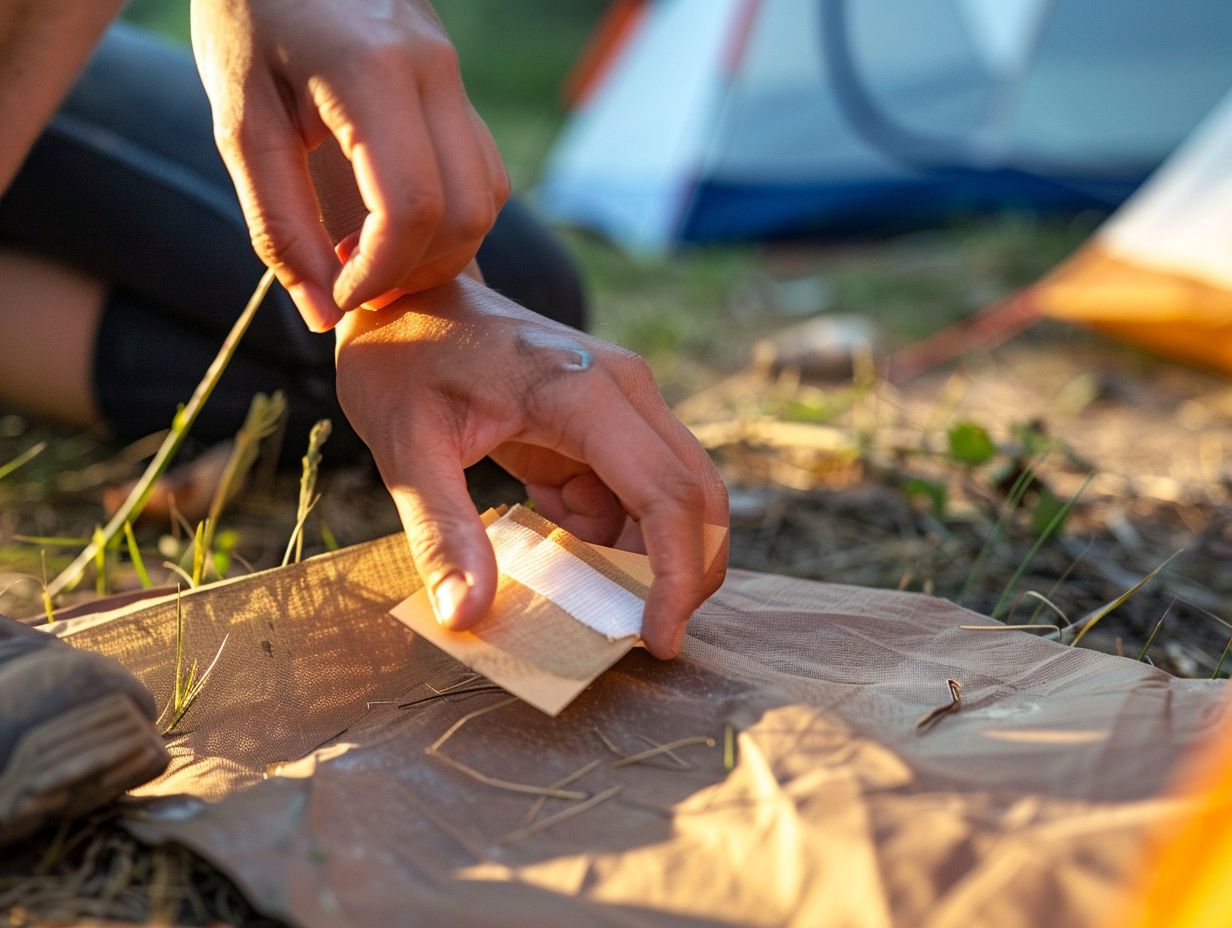
It is essential to have an understanding of and a swift response to heat-related illnesses, particularly heatstroke, to ensure safe summer camping. Heatstroke can be recognised by symptoms such as confusion, rapid heartbeat, and hot, dry skin. Failure to promptly address heatstroke can result in organ damage or potentially fatal outcomes.
To prevent heat-related illnesses, individuals engaging in camping activities should maintain proper hydration levels and reduce physical exertion during the peak heat periods of the day.
In case of an emergency, it is imperative to seek immediate assistance and relocate the affected individual to a shaded area, while administering cooling measures such as cold compresses or cold water. Adhering to these preventive measures will help guarantee a secure and enjoyable camping experience.
7. Know How to Respond to Allergic Reactions
Understanding how to manage allergic reactions, which involves the proper use of an EpiPen and antihistamines, is paramount in ensuring the safety of campers. Recognising the indicators of an allergic reaction plays a critical role in delivering timely assistance. Symptoms can manifest as hives, swelling, breathing difficulties, or a decline in blood pressure.
Upon observing these symptoms in a camper, the initial course of action involves administering the EpiPen if it is accessible, adhering to the provided instructions. Subsequently, promptly contact emergency services and inform the camper’s designated emergency contact.
While awaiting professional help, it may be advisable to consider administering an antihistamine to the individual if deemed suitable. Establishing a well-structured emergency response strategy can significantly enhance the efficacy of managing such circumstances.
8. Understand How to Handle Sprains and Strains
Effective management of sprains and strains through fundamental first aid techniques is crucial in preventing further injury and facilitating the recovery process.
When confronted with a sprain or strain, it is important to adhere to the mnemonic R.I.C.E. – Rest, Ice, Compression, and Elevation. Immobilisation of the affected area using a SAM splint or a splint fashioned from materials such as cardboard or magazines can minimise movement and alleviate pain. Over-the-counter analgesics like ibuprofen or paracetamol can offer relief from discomfort.
It is imperative to refrain from bearing weight on the injured limb and to promptly seek medical attention in cases of pronounced swelling, numbness, or an inability to move the joint.
What to Include in a First Aid Kit for Camping
A comprehensively equipped first aid kit plays a vital role in any camping trip, providing the necessary tools to deal with a diverse range of medical emergencies.
Essential components of the kit include antiseptic solutions, gauze dressings, plasters, and medical adhesive tape for the treatment of minor wounds, while additional items such as surgical gloves, tweezers, and moleskin address more severe injuries and conditions.
1. Bandages and Gauze
Dressings and gauze are essential components of any first aid kit, playing a crucial role in wound management and haemostasis. These products are available in various forms, including adhesive dressings, gauze bandages, and elastic bandages, each designed for specific wound types and applications.
Adhesive dressings are well-suited for addressing minor cuts and grazes, while gauze bandages offer versatility in dressing larger wounds or wrapping injuries. Elastic bandages, on the other hand, are instrumental in providing compression to reduce swelling or stabilise joint injuries.
It is imperative to ensure that the wound is clean and dry before applying any dressing. Care should be taken to gently cover the wound with the dressing, avoiding excessive tightness to allow for adequate circulation and promote proper healing.
2. Antiseptic Wipes and Ointment
It is imperative to have antiseptic wipes and ointment on hand to prevent infections and facilitate proper wound care during wilderness excursions. When engaging in camping activities, it is essential to ensure that these supplies are easily accessible within your first aid kit.
To utilise the antiseptic wipes effectively, the initial step involves cleansing the area surrounding the wound to eliminate any foreign particles or debris. Subsequently, the antiseptic wipe should be applied gently over the wound to disinfect it. Following this, a thin coating of antiseptic ointment should be administered to the wound to facilitate healing and deter bacterial proliferation.
Maintaining the cleanliness and protection of wounds with these products is instrumental in averting complications and facilitating a seamless recuperative process amidst the backdrop of nature’s allure.
3. Pain Relievers
Analgesics such as aspirin and anti-inflammatory drugs play a vital role in pain management and inflammation reduction during outdoor excursions, such as camping trips.
It is advantageous to include over-the-counter medications like paracetamol or ibuprofen in your first aid kit, as they target different types of pain. Paracetamol is effective in alleviating fever and mild to moderate pain, while ibuprofen excels in addressing inflammation and muscle soreness.
It is advisable to maintain a diverse selection of pain relievers in your kit to address a range of discomforts that may arise while engaging in outdoor activities.
Always adhere to the recommended dosages specified on the packaging and seek guidance from a healthcare professional if uncertain about the appropriate usage.
4. Tweezers and Scissors
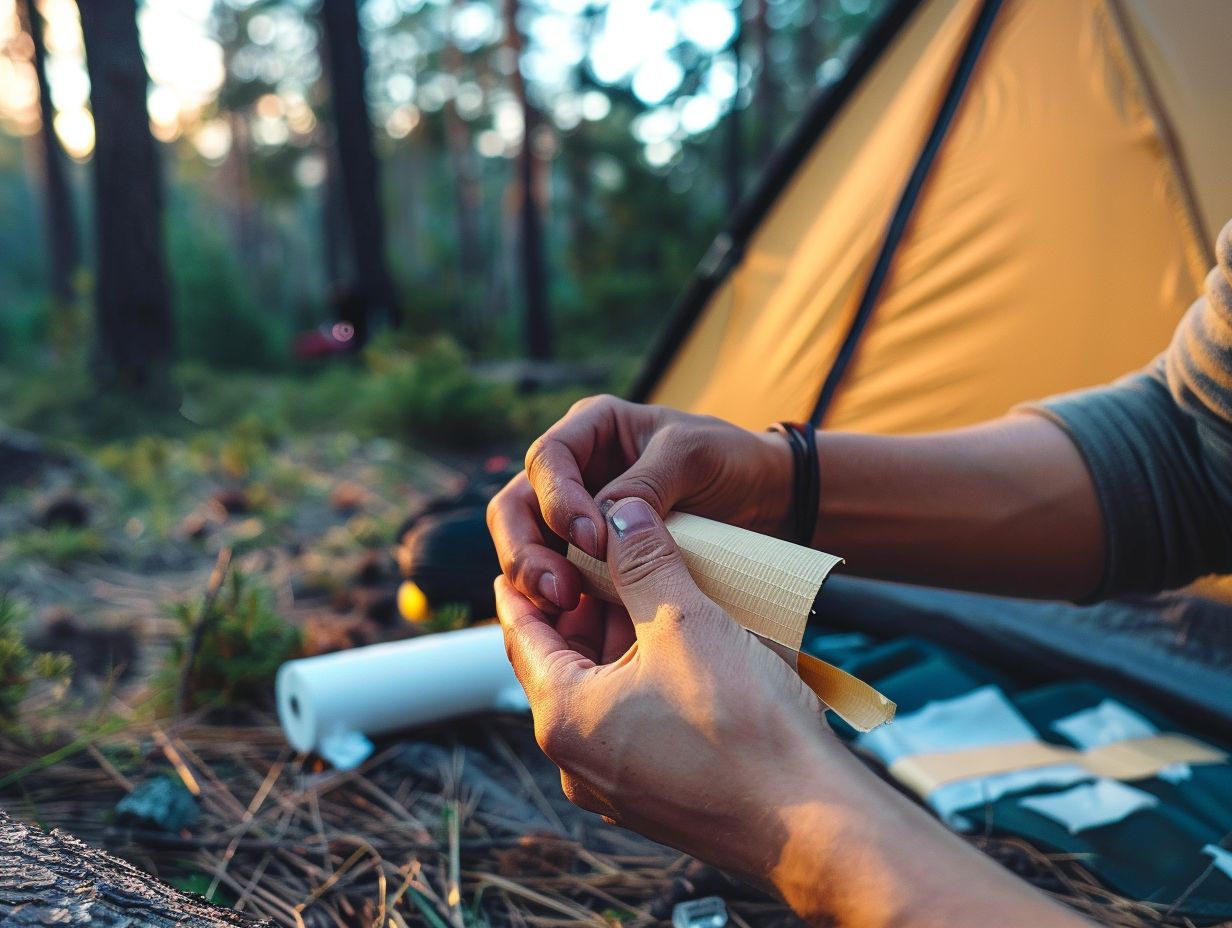
Tweezers and scissors play vital roles in a first aid kit, serving important functions in wound care and managing insect stings. Tweezers are particularly valuable for extracting splinters embedded in the skin due to their ability to offer precise grip and control. Conversely, scissors are essential for cutting bandages to the appropriate size for effectively dressing wounds.
In situations involving insect stings, tweezers are beneficial for delicately removing the stinger to prevent additional irritation. The presence of both these tools readily accessible guarantees that minor injuries can be promptly addressed, thereby minimising the likelihood of complications and facilitating expedited healing processes.
5. Emergency Contact Information
Ensuring the availability of an emergency contact list is paramount for expedited communication and effective emergency management whilst on camping excursions.
Apart from detailing the names and contact numbers of designated emergency contacts, it is imperative to incorporate pertinent medical information such as allergies, medications, and existing health conditions. This data holds critical importance for first responders in the event of an emergency.
It is advised to consistently update this list and maintain its accessibility within the first aid kit. Consider the option of laminating the list or storing it in a waterproof container to uphold its safety and legibility in diverse outdoor conditions. Exhibiting preparedness and organisation in advance can yield a substantial impact on emergency scenarios.
6. Personal Medications
It is imperative to include personal medicines, such as antihistamines, anti-diarrhoeal, and anti-inflammatory drugs in your first aid kit to ensure readiness.
These medicines are vital in addressing unforeseen health issues that might arise during camping expeditions.
Antihistamines are effective in treating allergic reactions triggered by insect bites or plants, while anti-diarrhoeal medicines offer relief from gastrointestinal disturbances resulting from contaminated food or water. Anti-inflammatory drugs like ibuprofen can mitigate pain and inflammation caused by minor injuries or muscle strains.
Regularly reviewing the expiry dates of these medicines and replacing any that have expired is essential to maintain their efficacy when required.
7. Emergency Blanket
The emergency blanket serves as a vital component within a camping first aid kit, offering crucial heat retention capabilities and safeguarding against hypothermia. Beyond outdoor pursuits, these versatile blankets find utility in medical crises by aiding in the regulation of body temperature fluctuations.
Their compact dimensions and lightweight composition facilitate easy transportation, ensuring readiness for unanticipated circumstances.
Constructed from a reflective material, emergency blankets possess the capacity to retain and reflect up to 90% of body heat, thereby aiding in the prevention of heat dissipation. Their waterproof and windproof attributes contribute to their efficacy in adverse environments, rendering them critical in scenarios demanding survival preparedness.
8. First Aid Manual
A first aid manual, such as those offered by reputable organizations like the American Red Cross, is a highly valuable resource for understanding emergency procedures and safety guidelines.
It functions as an extensive guide that provides individuals with the necessary knowledge to manage a wide range of medical situations, ranging from minor cuts and burns to more severe injuries.
The presence of a first aid manual in your emergency kit enables you to respond appropriately during critical moments, ensuring the safety and well-being of yourself and those around you.
This resource delivers detailed, step-by-step instructions on crucial procedures like CPR, wound care, splinting techniques, and various other essential practices, establishing it as a pivotal element in any comprehensive emergency preparedness kit.
When to Seek Professional Medical Help?
Understanding the appropriate time to secure professional medical assistance is imperative whilst on camping excursions. Instances involving severe injuries and medical emergencies necessitate the skills and resources available through emergency medical services, such as those offered by Aspen Valley Hospital.
1. Severe Injuries or Illnesses
Serious injuries or illnesses, such as fractures and septic shock, demand prompt medical attention and should not be managed solely through first aid measures. In the case of fractures, individuals may experience visible deformities, intense pain, or an inability to move the affected limb.
It is imperative to seek professional medical assistance to ensure appropriate setting and treatment, thereby mitigating the risk of enduring complications.
In the instance of conditions like septic shock, symptoms such as a rapid heart rate, confusion, and low blood pressure indicate a critical situation necessitating immediate intervention in a hospital environment.
Timely recognition of these indicators and prompt engagement with emergency medical services can significantly impact the outcome and subsequent recovery trajectory.
2. Allergic Reactions
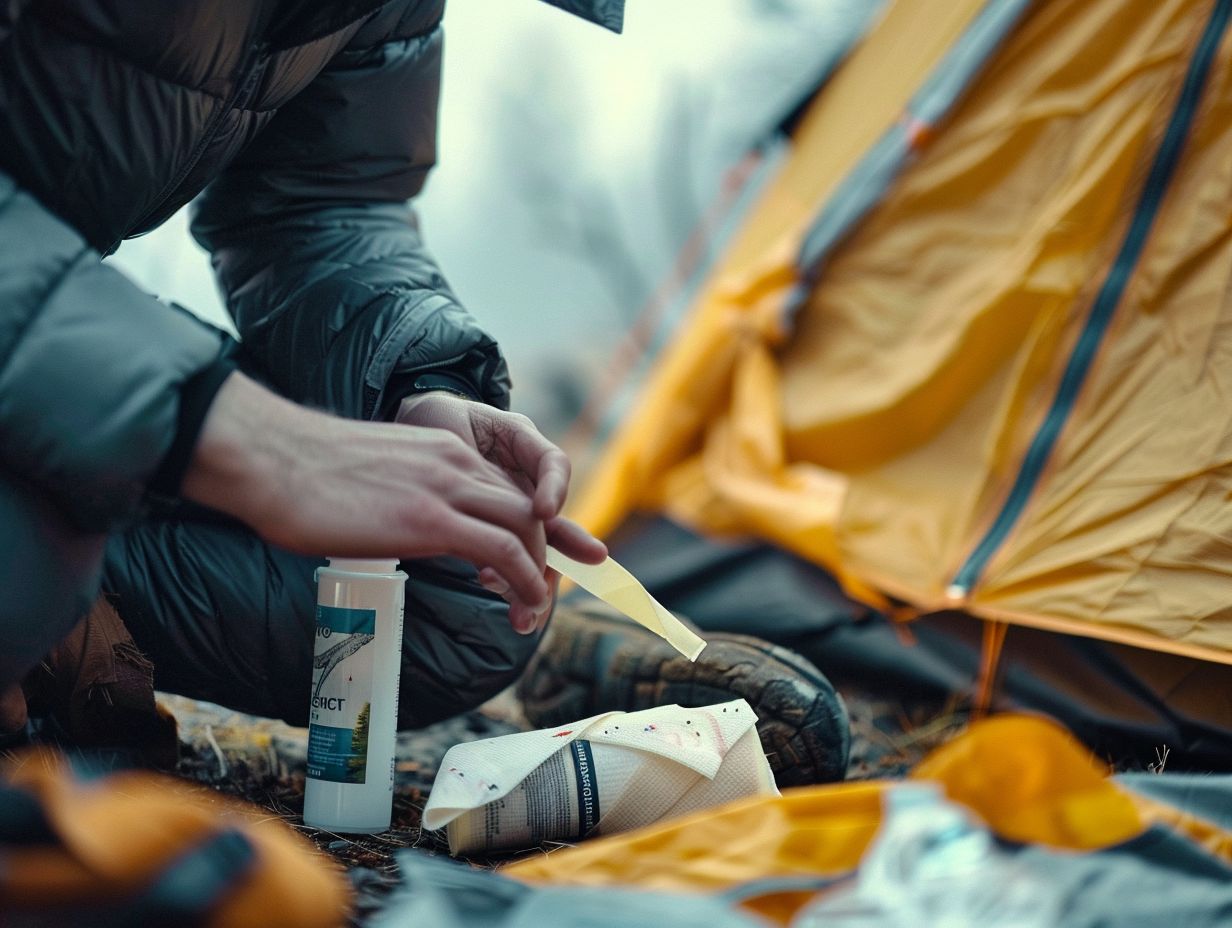
Severe allergic reactions can progress rapidly, emphasising the importance of having an EpiPen or antihistamines readily available. However, in cases of severe reactions, it is essential to seek professional medical assistance without delay.
Symptoms of severe allergic reactions may include difficulty breathing, facial or throat swelling, and a sudden decline in blood pressure. Timely administration of the EpiPen by injecting it into the thigh and holding it for a specified duration is crucial. Subsequently, the use of antihistamines can aid in symptom management.
Despite the immediate administration of these interventions, it remains imperative to contact emergency services or proceed to the nearest medical facility for thorough evaluation and treatment. This approach is necessary as severe allergic reactions have the potential to be life-threatening.
3. Persistent Symptoms
Persistent symptoms, such as ongoing pain or fever, may be indicative of underlying medical emergencies that necessitate the involvement of emergency medical services.
Failure to address persistent symptoms may result in the exacerbation of health conditions and the development of complications that could have been mitigated with prompt medical attention. For instance, enduring chest pain could be an indication of a heart attack, while sudden and severe headaches may signify a stroke.
Similarly, persistent coughing, unexplained weight loss, or prolonged fatigue should not be disregarded, as they may be symptomatic of serious illnesses like cancer or autoimmune disorders. It is imperative to promptly seek medical assistance for such symptoms to enable early diagnosis and the implementation of effective treatment strategies.
4. Difficulty Breathing or Chest Pain
Signs such as difficulty breathing and chest pain are indicative of a critical medical emergency that necessitates immediate professional intervention, such as the services rendered by Aspen Valley Hospital.
When an individual or someone known to you experiences an abrupt onset of breathing difficulties or chest pain, it is imperative to take swift action. Contact emergency services or promptly seek medical aid.
In the interim, assist the affected individual in assuming a comfortable position, loosening any constricting garments, and providing reassurance while awaiting assistance. It is essential to bear in mind that timely medical attention can be life-saving in circumstances of this nature, as they could signify severe underlying health conditions necessitating immediate medical intervention.
Frequently Asked Questions
What are some essential first aid tips for campers?
1. Always carry a first aid kit with you containing bandages, gauze, antiseptic solution, and other basic supplies.
2. Be aware of any allergies or medical conditions of your fellow campers and have necessary medications on hand.
3. Wear appropriate clothing and footwear to prevent injuries, especially when hiking or participating in outdoor activities.
4. Stay hydrated and well-rested to avoid exhaustion and heat-related illnesses.
5. Know how to treat common camping injuries such as burns, cuts, and insect bites.
6. Stay updated on basic first aid techniques such as CPR and the Heimlich manoeuvre.
How can I prevent common camping injuries while on a trip?
1. Check the weather forecast and prepare for extreme weather conditions if necessary.
2. Avoid touching or eating poisonous plants and insects.
3. Use sunscreen and wear protective clothing to prevent sunburn.
4. Stay hydrated and take breaks when needed to avoid exhaustion.
5. Use caution when setting up campfires and make sure they are properly extinguished before leaving.
6. Keep a safe distance from wild animals and do not feed them.
What should I include in my first aid kit for a camping trip?
1. Bandages and gauze of various sizes.
2. Antiseptic solution or wipes.
3. Ointments for burns, cuts, and insect bites.
4. Pain relievers and anti-inflammatory medication.
5. Allergy medication and EpiPen if necessary.
6. Tweezers, scissors, and safety pins.
7. Emergency contact information and a list of any medical conditions or allergies.
8. A flashlight and whistle for signalling for help.
9. A map of the area and a compass.
10. Any necessary medications for chronic conditions.
What steps should I take if someone is injured during a camping trip?
1. Assess the situation and call for help if necessary.
2. Administer first aid using your first aid kit.
3. If the injury is severe or life-threatening, do not attempt to move the person and wait for medical professionals to arrive.
4. Keep the injured person warm and comfortable while waiting for help.
5. If there is bleeding, apply pressure to the wound until it stops.
6. Stay calm and reassure the injured person until help arrives.
Are there any special considerations for first aid when camping with children?
1. Make sure to pack child-specific medications and supplies in your first aid kit.
2. Keep a close eye on children during outdoor activities to prevent injuries.
3. Teach children basic first aid techniques and what to do in case of emergency.
4. Be aware of any allergies or medical conditions of the children in your group.
5. Have a designated adult in charge of administering first aid for children.
6. Keep emergency contact information for the children’s parents or guardians on hand.
What are some important first aid tips for camping in remote areas?
1. Have a detailed map and plan your route in case of emergencies.
2. Carry a satellite phone or other means of communication in case of emergency.
3. Research the area and be aware of potential hazards such as wildlife or extreme weather.
4. Make sure to have enough supplies and food in case of unexpected delays.
5. Plan for medical emergencies and have a backup plan in case of limited access to medical facilities.
6. Have a guide or experienced camper with you who is trained in first aid and survival skills.

